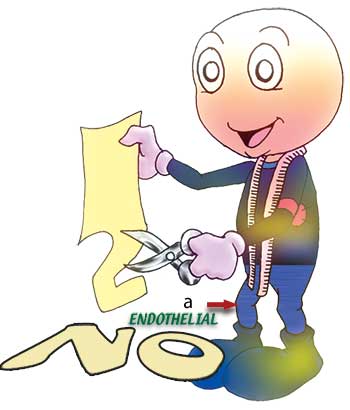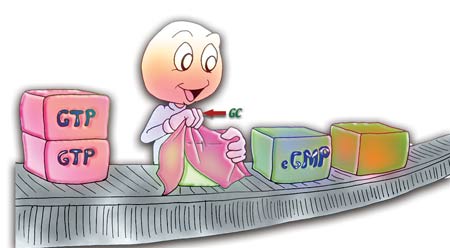23. Nitric Oxide: A Skilled Messenger
Nitric oxide (NO) is a colorless, but toxic gas obtained by the oxidization of nitrogen—a molecule formed by the combination of one nitrogen and one oxygen atom. Despite its toxicity, this molecule has an attribute of the greatest importance for human life. Over the last 20 years, intense research has revealed that this molecule undertakes a fundamental task in communication among cells. Results of this scientific endeavor have shown that nitric oxide is a hormone produced naturally in the human body, as yet another chemical messenger that plays a strategic role in the regulation of functions in the nervous, circulatory, immune, respiratory and reproductive systems.
 |
| a. Endothelial |
| Figure 91: The endothelial cell produces molecules of nitric oxide (NO). |
One location where NO undertakes a most important duty is in the veins. The internal diameter of the veins is not fixed, but expands and contracts according to our activities, thus playing an important role in regulating our blood pressure. Thanks to this immaculate system, the body’s needs are met, even while vary according to the surrounding environment. When you play sports, your blood vessels expand to supply the increasing demand for blood flow; and following injury they contract, reducing possible blood loss—all as a result of the ideal system in question.
So how is it that the veins know when to expand and when to contract? Research has revealed the presence of a chemical messenger: the NO molecule. It is this molecule, consisting of two atoms, that issues the command for blood vessels to expand and contract.
Let us now examine the splendid facilities that produce NO in the depths of your circulatory system.
Under an electron microscope, veins can be seen to have a perfect structure, in inverse proportion to their size. For example, 10 capillary vessels aligned side by side are no thicker than a human hair. These narrow vessels’ internal walls are covered by a layer consisting of flat-muscle cells; expansion and contraction of the veins take place as a result of these muscles’ activities. The muscle cells do not come into direct contact with the blood, because the endothelial cells form a membranous layer between the muscle cells and the blood flow.
Like links in a chain, these cells combine together to comprise the endothelial layer. Until the 1980s it was believed that these cells had no other effect than to facilitate the flow of blood in the veins. The truth emerged only later, when it was realized that one of the endothelial cells’ responsibilities is to produce the messenger molecule NO (Figure 91).
If we compare the endothelial cell to a factory, you can think of the NO molecules as its products. The life span of each NO molecule is about 10 seconds, but NO is created to transmit the messages it carries during that brief span—which it does in the most perfect manner. The messenger NO molecules secreted by the endothelial cells begin being carried by the blood in all directions at high speed. Those that move towards the flat-muscle cells enter these cells’ membranes. The highly selective flat-muscle cell membrane recognizes the NO and permits it to pass through. The NO molecules entering the cell are immediately located by a special enzyme known as GC, and transmit their vitally important messages. A series of complex chemical reactions are thus initiated inside the cell (Figure 92).
 |
| Figure 92: NO molecules transmit vitally important messages to a special enzyme called GC. |
These proteins, which we referred to as messengers, are molecules, a mere 0.0000001 millimeter in size. These molecules work like a mail carrier, finding the enzyme GC to which the messages they carry are “addressed.” The message is forwarded to the correct enzyme, every single time. In addition, these messenger molecules’ lifespan is very limited, yet they never make any errors of timing. The message-bearing NO molecules have no compasses or other devices to help them find their way, yet they never become lost.
During this process, the speed of the NO molecule is reminiscent of communications established by Internet technology, or e-mail. NO acts just like an electronic postal system, transmitting a great many messages to their correct destinations at a very high speed.
The GC in the flat-muscle cells, receiving the messages carried by the NO, then goes into action. This worker enzyme’s duty is to convert GTP, an energy-carrying molecule, into cGMP. The many reactions taking place during this process have not yet been fully understood (Figure 93).
To explain it as simply as possible, as a result of the enzyme activities, the calcium concentration in the muscle cells decreases, leading to the fibers separating and the muscle cells expanding. In this way, the veins themselves expand. The message carried by the NO molecules play a vitally important role in the regulation of the pressure inside your veins.
 |
| Figure 93: The enzyme GC converts GTP, energy-bearing molecules, into cGMP. |
It must not be forgotten that what is described here is just one of the billions of complex communication processes continuing at every moment inside our bodies.
At this point, a number of questions need answering: How is it that unthinking, unconscious NO molecules so perfectly recognize systems that even the world’s most esteemed academics have been unable to unravel? How do they know when to go into action or stop, right down to the millisecond? As soon as they are produced, how can they forward their messages at high speed, to exactly the right sites and at exactly the right time, as if they had received detailed instructions?
No doubt NO cannot perform all these wondrous tasks of its own accord. This molecule, like the millions of other molecules in nature, is the work of a flawless Creation. And for thoughtful people, it is just one of the proofs of God's infinite might and knowledge.
We will show them Our Signs on the horizon and within themselves until it is clear to them that it is the truth. Is it not enough for your Lord that He is a witness of everything? What! Are they in doubt about the meeting with their Lord? What! Does He not encompass all things? (Surah Fussilat, 53-54)
- Introduction
- 1. Monitors That Control the Level of Fluids in the Blood
- 2. The Body's Impeccable Security System
- 3. Mother's Milk and the Hormone Oxytosin
- 4. Calcium Measurers
- 5. The Sugar Factory
- 6. Emergency Assistance The Hormone Adrenaline
- 7. The Lysosomal Enzymes That Purify the Body
- 8. The Flowless System That Regulates Blood Pressure
- 9. Growth Hormone
- 10. The Clock in Our Bodies That Never Goes Wrong
- 11. The Miraculous Molecule That Regulates Body Temperature
- 12. An Extraordinarily Delicate Balance
- 13. Hormones That Prepare the Way For the Baby -1
- 14. Hormones That Prepare the Way For the Baby -2
- 15. The Hormones in the Male Reproductive System
- 16. Other Properties of the Hormone Testosterone
- 17. Hemoglobin: The Miraculous Oxygen – Bearing Molecule
- 18. The Communications System in the Cell
- 19. The Messenger Hormone's Journey within the Cell
- 20. Communication Control in the Cell
- 21. Protein Traffic within the Cell
- 22. Chemical Communication in the Nerve Cell
- 23. Nitric Oxide: A Skilled Messenger
- 24. The Endothelial Cell: A Nitric Oxide Production Center
- 25. The Power Station in the Human Body
- 26. The
- 27. DNA Replication
- 28. Repair Enzymes
- 29. Protein Production
- 30. The Final Stage of Protein Production
- 31. The Cell Membrane and 100 Trillion Organized Workers
- 32. What Happens at the Moment of Hearing?
- 33. Blood Clotting
- 34. The Immune System
- 35. The Journey of Vitamin B12
- 36. The Pancreas: The Human Body's Chemist
- 37. Transporter Molecules in the Cell Membrane
- 37. Complement Proteins Responsible for Protecting the Body
- 39. Anti – Acid Formulas Producing Molecules
- 40. The Consciousness Displayed by Egg Cells
- Conclusion
